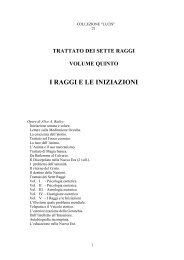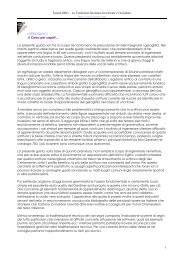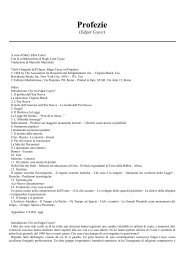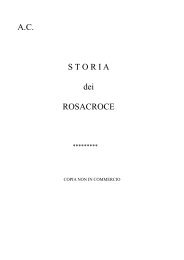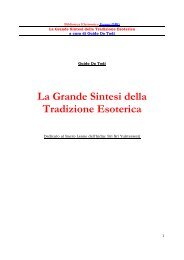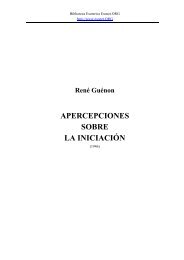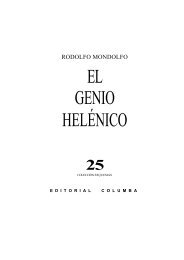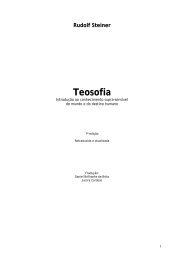Biblioteca Esoterica Esonet.ORG http://www.esonet.ORG 1
Biblioteca Esoterica Esonet.ORG http://www.esonet.ORG 1
Biblioteca Esoterica Esonet.ORG http://www.esonet.ORG 1
You also want an ePaper? Increase the reach of your titles
YUMPU automatically turns print PDFs into web optimized ePapers that Google loves.
<strong>Biblioteca</strong> <strong>Esoterica</strong> <strong>Esonet</strong>.<strong>ORG</strong><br />
<strong>http</strong>://<strong>www</strong>.<strong>esonet</strong>.<strong>ORG</strong><br />
consciousness of a whole. The whole may be a concrete, physical organism, a musical<br />
sonata composed of many notes arranged in a specific order according to a system of<br />
organization (tonality in Western culture), a mathematical theorem, the constitution and<br />
legal system of a nation, or any other organization of multiple elements, entities, or<br />
concepts. The terms form and shape often are used carelessly and interchangeably, but the<br />
word shape should be used only with reference to an entity's external appearance. The<br />
shape of an object or a body can be described objectively and in terms pf physical<br />
sensations; it can also, at least in principle, be measured. But one cannot measure the form<br />
of a concept or a metaphysical system. One can claim that form exists in space; but if one<br />
means only the space of the physical, material world, one ignores the fact that a system of<br />
closely interrelated ideas has form (but one might also say "structure") yet exists only in a<br />
mental kind of space. It is "mental" because the system is a complex organization of<br />
relations which are not necessarily embodied in material entities, though the creator of the<br />
system may use concrete images or physical experiences as symbols to evoke his or her<br />
meaning.<br />
Today we are well aware of the principle of inertia, which states that any object at rest<br />
or in uniform motion in a particular direction will remain at rest or continue in motion<br />
unless acted upon by some external force. Inertia, in the broadest sense of the term, is<br />
resistance to change. The speed and direction of a moving object resist change; similarly<br />
the basic character of any form is to resist change, that is, to perpetuate the particular set of<br />
relationships which made it what it is. All religious, social, and cultural institutions have<br />
intense inertia. Once formed and set into operation, usually they can be transformed only<br />
with great difficulty. A culture as a whole slowly — or in some instances rapidly —<br />
changes; it "evolves" generation after generation insofar as its outer modes of operations,<br />
fashions, and even some of its ideals are concerned. Yet its basic assumptions, religious<br />
beliefs, and fundamental symbols and characteristics of living are extremely tenacious;<br />
violent crises or disasters may be needed before a really new beginning can occur. The<br />
same can be said of a person's ego which, in a sense, operates as a private institution with<br />
its own routine, long held beliefs, and resistance to transformation.<br />
If mind (at whatever level it operates) is the formative agent that produces form out of<br />
sets of relationships, what then transforms mental organizations or physical organisms?<br />
What is it that overcomes the inertia inherent in formations once they are stabilized? It is<br />
the momentum of the Movement of Wholeness manifesting as the continuum of change —<br />
the foundation of what we call time. Again we encounter a dualism: continuous change<br />
and the tendency in forms (complexes of relations) to persist and perpetuate themselves.<br />
Such a dualism is not essentially different from that of Multiplicity and Unity; for just as<br />
human beings have sought and still seek inner psychological security in imagining and<br />
deifying a Supreme One, beyond and impervious to multiplicity, they have conceived of<br />
Him (or It) as changeless — often as the Perfect Form of being.<br />
The acceptance of both constant change and permanent forms of being gives rise to the<br />
concept of a divine (or quasi-divine) realm of persistent archetypal forms and the world of<br />
ever-changing earthly existence in physical substance. Mind operates at both levels, the<br />
archetypal and the existential, but it operates differently at each because the types of forms<br />
90



